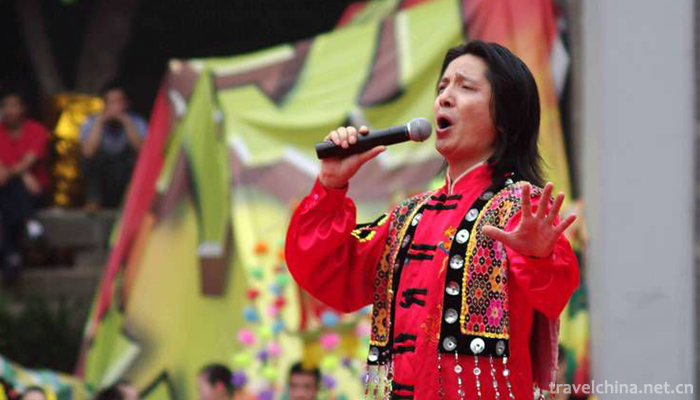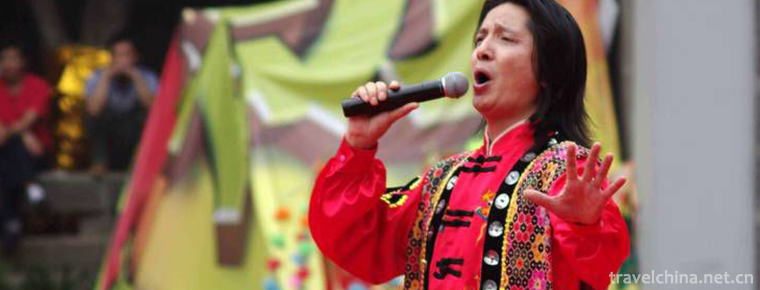Shizhu Tujia Luoer Diao
Shizhu Tujia Luoer Diao
Shizhu Tujia Luoer Diao originated from Shizhu Tujia Autonomous County, Chongqing. It is a folk song of Luoer tune, which is popular among the Han and Tujia nationalities in southeastern Chongqing. It is named for Luoer in its lyrics.
On May 20, 2006, Shizhu Tujia Luoer was approved by the State Council to be included in the first batch of national intangible cultural heritage list.
historical origin
Shizhu Tujia Luoer Diao has a long history, which is in line with the widely spread bamboo branch CI in Bayu area of Tang Dynasty. Some people believe that "Er Diao" has the ancient "bamboo branch ci" legacy, known as the "bamboo branch ci" living fossil. Because it is easy to improvise, full of life interest, singing and catchy, so it is widely circulated.
artistic characteristics
The tune of Tujia Lore in Shizhu is concise, each tune has a range of less than eight degrees, and there are few decorations in the tune. The tune is fluent, easy to master and easy to sing. Its tones are mostly symbolic, feathery and commercial, with both traditional repertoire and improvisational melody.
The lyrics and sentences are mostly seven-character sentences, which can be improvised, played on the spot, and express the singer's true feelings vividly and vividly. Some songs have the same tune but different lyrics, which are quite "bamboo branch lyrics". Some lyrics are straightforward and popular, which vividly reflect the local Tujia people's life, labor, folk customs, emotions and religious beliefs, and comprehensively record the Tujia people's ritual activities, living conditions and the evolution of national culture.
The rhyme of Er Dialect is simple and rich. Especially in Er Dialect, a large number of habitual dialect linings such as Er, Er and Er are used, which makes the tone of the tune closely combined with the four tones of the local Tujia dialect, and expresses the optimistic, open-minded, wise and humorous character of Tujia people, thus forming a unique style and charm.
During the long period of singing, an independent folk song with rich and varied content, concise and changeable melody and rich local rhyme has been formed, including life song, folk song, love song, couplet song, joke song, chant and countless repertoires.
Representative Works
There are songs such as "The Sun Comes Out Pleasantly", "Long-term Song", "Song of Pregnancy", "Little Lover" and so on.
Inheritance Significance
Children's tunes are rich and varied in content, concise and changeable in tune, rich in local rhyme and have important value in textual research of Bayu's history and exploration of folk songs.
In the 1950s and 1960s, more than 300 people in Shizhu Tujia Autonomous County were able to sing "children's tune". With the change of social culture, there were fewer and fewer singers. According to preliminary investigation, only about seventy singers can sing now. These singers are very old. The inheritance of children's tunes is facing difficulties and are on the verge of extinction.


-
1.Tiantai Mountain Scenic Area
Tiantai Mountain Scenic Spot, National AAAAA Class Tourist Spot, National Key Scenic Spot, One of China's Top Ten Famous Mountains, National Eco-tourism Demonstration Zone, Zhejiang Top Ten Tourist Sp
Time 2018-12-07 -
2.Bijiashan Scenic Area
Bijiashan Scenic Area is located in Tianqiao Town, Jinzhou City, Liaoning Province. The main scenic spots are Bijiashan Island and "Tianqiao", which are divided into five areas: island sight
Time 2019-01-02 -
3.Hengdian Film and Television City Scenic Area
Hengdian Film and Television City is a large-scale comprehensive tourist area which integrates film and television, tourism, vacation, leisure and sightseeing. It has been rated as the national AAAAA-
Time 2019-01-13 -
4.Golden Sands Beach
Golden Beach is located in the southern end of Shandong Peninsula, the Yellow Sea coast of Qingdao Huangdao District, Golden Beach Road. It is bordered by the Yellow Sea in the South and stretches
Time 2019-01-26 -
5.Multi voice Folk Songs of Hani Nationality
Hani multi-voice folk songs are popular in several Hani villages in the eastern part of Azahe Township, Honghe County, with Puchun Village as the center. Their natural environment is closed and traffi
Time 2019-05-02 -
6.Han tune
The mast of Hanzhong Diaoqu, a local traditional drama in Hanzhong City, Shaanxi Province, is one of the national intangible cultural heritages.
Time 2019-05-02 -
7.Glass Firing Techniques
Glass firing technology, Beijing Mentougou District, Shanxi Province, local traditional handicraft, one of the national intangible cultural heritage.
Time 2019-05-14 -
8.Qiang Nationality Year
The Qiang Year is a traditional festival of the Qiang people, also known as the Year of the Youth, which is held on October 1 of the lunar calendar every year. In Maoxian area, there are special regul
Time 2019-06-10 -
9.The Decorative Techniques of Yi Lacquerware
Yis lacquerware decoration technology chooses high-quality azalea, acid wood, camphor wood as raw materials, through sawing, planer, grinding, sticking and other processes, and then carefully paint th
Time 2019-07-12 -
10.New brown leaf weaving
Xinfang Brown edition is one of the traditional handicraft products in China. It has entered the third batch of national intangible cultural heritage list recommendation project list. It originated in
Time 2019-08-16 -
11.Chengdu University of Technology
Chengdu University of Technology was founded on March 15, 1956 and approved by the State Council. On March 27, the Ministry of Higher Education and the Ministry of Geology jointly issued a paper based
Time 2019-08-31 -
12.Chengdu Metro Line 1
Chengdu Metro Line 1 is the first metro line to be completed and put into operation in Chengdu, Sichuan Province, China. It is the first metro line opened in Western China. The first phase of the project was opened on September 27, 2010, The phase II project (Century City station to Guangdu station)
Time 2020-11-28